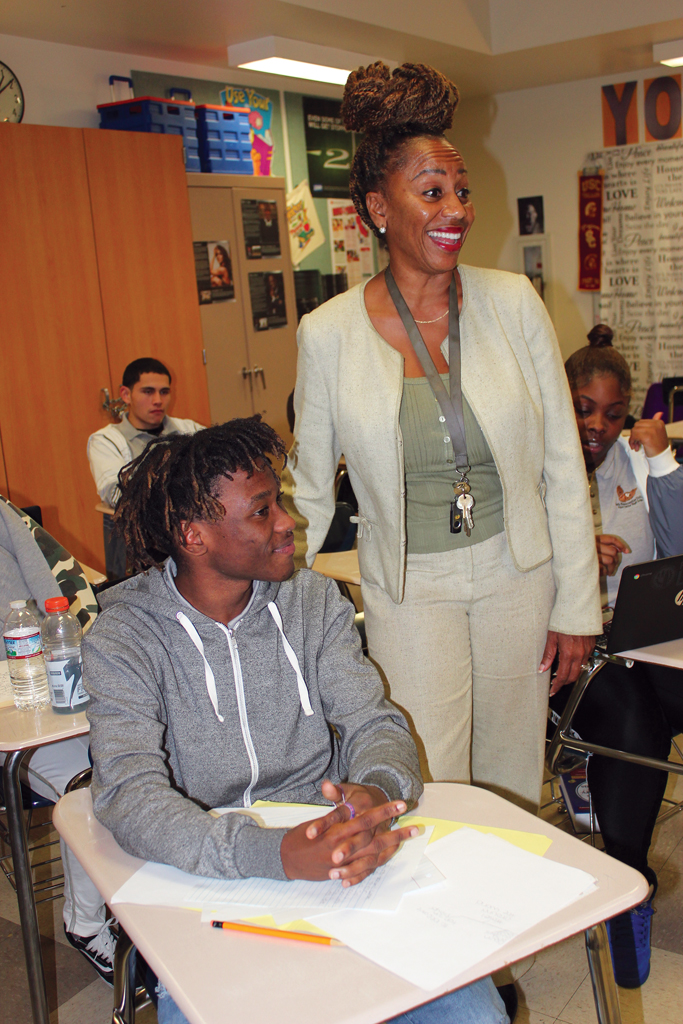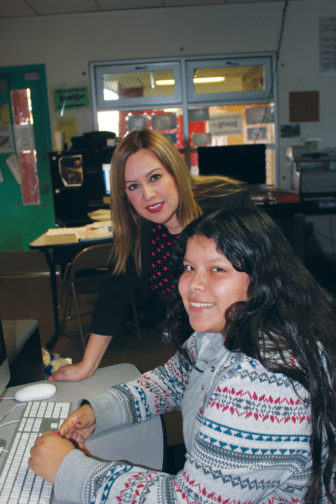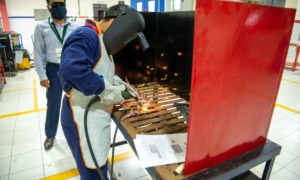
Assistant Principal Clarice Henry (standing) with student Jordon Taylor at Youth Opportunities Unlimited, which is part of the Rita D. Walters Learning Complex, a youth and family center that has provided kids and young adults with education, recreation and professional help since its founding in 2002.
Photos courtesy Youth Opportunities Unlimited, LAUSD
LOS ANGELES — Last year, 11th-grader Terri Holden, 17, found herself on the road to dropping out of high school — like one in every four students enrolled in the Los Angeles Unified School District who won’t make it to their high school graduation.
“I wasn’t focused on me at the time,” Terri said. “At my old school it was a lot of people and … most teachers just gave us some work and said do this and that’s your grade.”
After falling behind her sophomore year, Terri was not on track to graduate. But now she is student council vice president at a school in South Los Angeles that changed her course.
Youth Opportunities Unlimited is an alternative high school devoted to helping struggling students earn their diplomas. It serves about 350 students ages 14 to 21 from all over the Los Angeles area who have left high school but want to finish their degrees. It is part of the Rita D. Walters Learning Complex, a youth and family center that has provided kids and young adults with education, recreation and professional help since its founding in 2002.
 “I came in January this year and I was behind,” Terri said. “But the way they described the school to me I could tell that they really cared about helping all their students succeed and graduate high school.”
“I came in January this year and I was behind,” Terri said. “But the way they described the school to me I could tell that they really cared about helping all their students succeed and graduate high school.”
As graduation rates increase, the statistics for high school dropouts look more grim. The national unemployment rate for Americans without a high school diploma is more than 7 percent, according to the U.S. Bureau of Labor Statistics, compared to the overall average of 4 percent for all Americans. Those who manage to keep a job are living on about $500 per week, compared to the average weekly wage of $885. High school dropouts are also twice as likely to live in poverty as college graduates.
Getting in after dropping out
One of the first lessons the school teaches is personal responsibility. And that starts with the application process.
“You interview with the principal to prove that you really want to graduate and get your credits up and school has become a priority,” Terri said. “They [want to] determine that you’re really serious.”
“We do a one-on-one interview where the parent and student must be present. We discuss student expectations, discuss what made them fall behind and set them goals,” said Principal Christina Green.
Assistant Principal Clarice Henry said once students are ready to take control of their education, they find a whole support system at the school.
“Our teachers, our administration and everybody on this campus genuinely care about the kids’ well-being. We want the kids to graduate; we’re one of their biggest cheerleaders,” she said.

Youth Opportunities Unlimited Principal Christina Green (leaning over the computer) works with Daniela Carrillo, one of 350 students at the Los Angeles Unified School District alternative school devoted to helping students ages 14 to 21 earn their diplomas.
With credit recovery classes and a flexible schedule, Henry said the school makes graduation efficient and attainable.
“Every 10 weeks kids have new schedules. And every 10 weeks they can get 25-30 credits,” Henry said. “We have a quarter system, that’s how they can get 100 credits in a year.”
Students who are pregnant or have young children can count on free child care on site. The learning complex offers classes in job training, economic literacy and parenting.
“They see the light at the end of the tunnel when they’ve had struggles before. It helps motivate them to try and do better,” Henry said.
Amid all the work, Youth Opportunities Unlimited makes time for traditional, social high school events.
“We have things like proms and grad nights and student council. We do have a lot of things a traditional school has,” Henry said.
Of the 75 percent of LAUSD students who graduated in 2016, nearly one-half used makeup classes or credit recovery programs. The district has received criticism for its heavy reliance on these alternatives, but the added pressure of increasing graduation rates to at least the U.S. average of 83 percent has forced their use.
LAUSD runs 57 option schools, including pregnant minor schools, community day schools, independent study options and continuation high schools. In fact, the system has more than 40 continuation schools throughout the district, serving thousands of non-traditional students, typically young people between 16 and 18 years old who are at risk of failing to graduate.
For those who dropped out of school at younger ages or decided to pick up their education after they turned 18, there aren’t as many options. Although online programs are available, people who can’t afford the fees may have no options for a diploma.
LAUSD is the second-largest public school system in the United States but has only one option school that reaches teenage and young adult dropouts. And even though Youth Opportunities Unlimited serves some of those who don’t fit into the other option schools available, it only enrolls about 350 students.
“We have no idea why that is, but we’re happy that we’re a part of it and give the kids the opportunity to graduate faster, especially when they’ve made mistakes in their life,” Henry said.
Administrators and students at the school agree its secret to success is an unparalleled support system that follows them until they walk at graduation in the spring.
“I tell them during the interview that every child comes here with a story and everyone comes here for a reason. And it’s OK whether it was their mistake or something happened in their life and set them back,” Green said. “Once you’ve come here you’re committed. We will make sure that you graduate, and high school graduation is only the first step.”
With graduation fast approaching, Terri is now looking at colleges in Arizona and Louisiana. She plans to major in creative writing and has dreams of becoming a screenwriter or an author.































